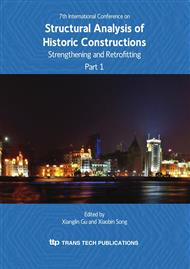[1]
Al-Emrani, M (2005). Fatigue Performance of Stringer-to-Floor-Beam Connections in Riveted Railway Bridges., Journal of Bridge Engineering, 10(2), 179-185.
DOI: 10.1061/(asce)1084-0702(2005)10:2(179)
Google Scholar
[2]
Al-Emrani, M, and Kliger, R (2003). FE analysis of stringer-to-floor-beam connections in riveted railway bridges., Journal of Constructional Steel Research, 59(7), 803-818.
DOI: 10.1016/s0143-974x(02)00114-1
Google Scholar
[3]
Assessment of Existing Steel Structures (2008). Recommendations for Estimation of Remaining Fatigue Life. Joint Report Prepared under the JRC - ECCS (programme of CEN/TC 250) - Editors: G. Sedlacek, F. Bijlaard, M. Géradin, A. Pinto and S. Dimora.
DOI: 10.1002/stco.200890018
Google Scholar
[4]
Brincker, R, Zhang, L, and Andersen, P (2000). Modal Identification from Ambient Responses using Frequency Domain Decomposition, in Proc. 18th International Modal Analysis Conference, San Antonio, TX.
Google Scholar
[5]
Bruhwiler, E, Smith, I, and Hirt, M (1990). Fatigue and fracture of riveted bridge members., Journal of the Structural Engineering, 116(1): 198-213.
DOI: 10.1061/(asce)0733-9445(1990)116:1(198)
Google Scholar
[6]
DiBattista, J D, Adamson, D E, and Kulak G L (1997). Fatigue strength of riveted connections., Journal of Structural Engineering, 124(7), pp.792-797.
DOI: 10.1061/(asce)0733-9445(1998)124:7(792)
Google Scholar
[7]
DiBattista, J D, Adamson, D E, and Kulak, G L (1998). Evaluation of remaining fatigue life for riveted truss bridges., Canadian Journal of Civil Engineering, 25, 678-691.
DOI: 10.1139/l98-011
Google Scholar
[8]
Imam, B M, Righiniotis, T D, and Chryssanthopoulos, M K (2007), Numerical modelling of riveted railway bridge connections for fatigue evaluation., Engineering Structures, 29(11), 3071-3081.
DOI: 10.1016/j.engstruct.2007.02.011
Google Scholar
[9]
Kulak, G L (1996). Fatigue strength of riveted connections. Stalhbau, 11, 445-451.
Google Scholar
[10]
Kulak, G L (2000). Fatigue strength of riveted shear splices., Progress in Structural Engineering and Materials, 2(1), 1-10.
DOI: 10.1002/(sici)1528-2716(200001/03)2:1<110::aid-pse13>3.0.co;2-6
Google Scholar
[11]
Matar, E B (2007). Evaluation of fatigue category of riveted steel bridge connections., Structural Engineering International, 1, 72-78.
DOI: 10.2749/101686607779938895
Google Scholar
[12]
Matar, E B, and Greiner R (2006). Fatigue test for a riveted steel railway bridge in Salzburg., Structural Engineering International, 16(3), 252-260.
DOI: 10.2749/101686606778026547
Google Scholar
[13]
Ostachowicz, W M, and Krawczuk, M (1991) Analysis of the effect of a cracks on the natural frequencies of a cantilever beam., Journal of Sound and Vibration 150, 191-201.
DOI: 10.1016/0022-460x(91)90615-q
Google Scholar
[14]
Pipinato, A (2010).
Google Scholar
[15]
Pipinato, A, and Modena, C (2009).
Google Scholar
[16]
Pipinato, A, Molinari, M, Pellegrino, C, Bursi, O, and Modena, C (2009b). Fatigue tests on riveted steel elements taken from a railway bridge., Structure and Infrastructure Engineering, DOI: 10. 1080/15732470903099776.
DOI: 10.1080/15732470903099776
Google Scholar
[17]
Pipinato, A, Pellegrino, C, Bursi, O, and Modena C (2009a). High-cycle fatigue behavior of riveted connections for railway metal bridges., Journal of Constructional Steel Research, 65(12), 2167-2175.
DOI: 10.1016/j.jcsr.2009.06.019
Google Scholar
[18]
Righiniotis, A, and Timothy, D (2008). Fatigue analysis of riveted railway bridge connections using the theory of critical distances., Engineering Structures, 30, (10), 2707-2715.
DOI: 10.1016/j.engstruct.2008.03.005
Google Scholar
[19]
Salawu, O S (1997) Detection of structural damage through changes in frequency: a review., Engineering Structures, 19, 718-723.
DOI: 10.1016/s0141-0296(96)00149-6
Google Scholar
[20]
Schiff, AJ, and Buckle, I G (1995). Critical issues and state-of-the-art in Lifeline earthquake engineering. TCLEE monograph n°7. ASCE. 92 p.
Google Scholar
[21]
Sustainable Bridges (2006).
Google Scholar


